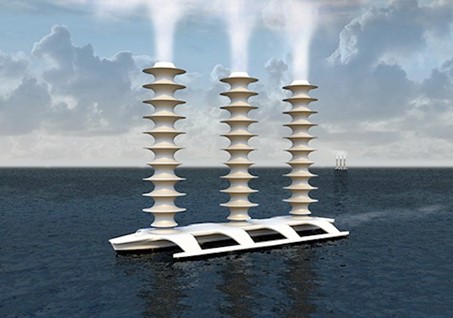Climate Change, Adaptation and Mitigation
CT-MI-226
Climate change is arguably the most severe challenge that our planet is facing the 21st century. Human interference is perturbing the climate system through emissions of greenhouse gases, changes in aerosol concentrations and changes in land use. Climate science aims to estimate how the climate is changing in the near and more distant future and its impact on our living and build environment. Engineering solutions are required to cope with the evolving climate change impacts (adaption) and to prevent further emissions (mitigation). In addition, even more drastic solutions might be needed design to undo the already committed climate changes (climate engineering).

Illustration of a cloud-brightening process by a ship that sprays salt particles into the air to reflect sunlight to slow global warming. Science Fiction or a Climate Engineering Possibility?
Minor code: CT-MI-226 Language: English
|
Education methods
Lectures and projectsFor whom?
All TU Delft BSc students as well as batchelor students from other universities with a basic background in physics and mathematics who are interested in the scientific, engineering, socio-economical and political aspects of climate change.
What will you learn
During this minor you will get engaged in the multifaceted scientific, engineering, socio-economical and political aspects of climate change.
From a climate science perspective, you will get an overview of the Earth’s climate system, learn how it is perturbed by human interference and discuss the consequences for the present and future climate. The impacts of climate change on humans and the build environment will be discussed: How is the delta where we live in affected by climate change through sea level rise, soil subsidence, changes in precipitation, river discharges, draughts, flooding and salt intrusion?
Adaption, mitigation and climate engineering measures are a central part in this minor. Which engineering solutions (adaptations) can we design to cope with these changes? What are the possibilities and limitations of mitigation measures to meet the emission reduction requirements? And can we construct climate engineering solutions to undo the already committed climate change?
Parallel to these engineering possibilities, the mitigation and adaptation options will also be analysed from an socio-economical and political perspective: how can we make engineering solutions feasible from a economical and acceptable from a social perspective. As a result, this minor will enable you to develop a broad view on climate change and its consequences and will be of great value for any specialisation later later on in your educational journey.
After this minor the student:
- has developed a basic understanding of climate physics and climate predictions, is familiar with the different sources of uncertainties in todays’ climate predictions, and can explain the impact of climate change on humans and the natural and build environment.
- understands the effectiveness and limitations of climate adaptation options being considered;
- recognises the options to mitigate climate change, knows how to characterise them, and understands how they interact;
- can assess climate adaptation and mitigation measures from an economical perspective.
- Is able to assess the risk and probability of a certain manifestation of climate change; is able to design adaptation, mitigation and climate engineering strategies for specific cases along with political and economic implementation analyses.
Course overview
-
During quarter 1 (Q1), 3 courses are offered:
- CT3080 The Science of Climate Change (5 EC)
(4 EC lecture, 1 EC project/Assignment) - CT3081 Climate Change Impact and Adaptation ( 5EC)
(4 EC lecture, 1 EC project/Assignment) - CT3082 Mitigation of Climate Change ( 5EC)
(4 EC lecture, 1 EC project/Assignment)
- CT3080 The Science of Climate Change (5 EC)
-
During the first half of the 2nd quarter (Q2), 2 courses are offered:
- CT3083 Climate Engineering (4 EC)
(3 EC lecture, 1 EC project) - CT3084 Political Economy of Climate Change (5 EC)
(4 EC lecture, 1 EC project)
During the second half of the 2nd quarter (Q2) you will be working on you end-project (6 EC).
- CT3085 End-Project (6 EC)
- CT3083 Climate Engineering (4 EC)
Contact

Pier Siebesma
Professor
- +31 15 27 85628
- A.P.Siebesma@tudelft.nl
-
Faculty of Civil Engineering and Geosciences
Building 23
Stevinweg 1 / PO box 5048
2628 CN Delft / 2600 GA DelftRoom number: 2.15